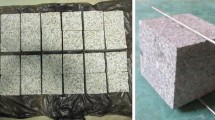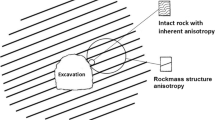Abstract
Please allow me to humbly offer a brief amendment on the empirical equation offered by Wang et al. (Geotech Geol Eng 35(4):1645–1655, 2017): \(JRC=1.319(1+2.826 \tan \beta )D_f\). This equation should be replaced by the corrected equation offered in this discussion: \(JRC=1.673(1+2.157 \tan \beta )D_f\). This statement is based on the fact that, as a previous step for the final formula achievement, the original authors established the basic friction angle (\(\phi _b\)) through tilt tests using three rock cores and applying the equation \(\phi _b=\frac{2}{\sqrt{3}} \tan \varphi\), while the applied equation should have been \(\phi _b=\frac{\sqrt{3}}{2} \tan \varphi\). The original authors’ calculi have been carefully revised in order to offer the above-corrected equation with the aim of enhancing and taking more profit of the original authors’ interesting contribution for predicting rock joint shear strength with geometrical data.
Similar content being viewed by others

Avoid common mistakes on your manuscript.
1 Introduction
Wang et al. (2017) offer a correlation among JRC and two geometrical surface roughness parameters: a fractal dimension (\(D_f\)) and a direction angle (\(\beta\)). For that purpose, JRC was back-calculated from tilt tests on natural rough surfaces (obtaining a tilt angle: \(\varphi\)) and applying Eq. (1) (Barton and Choubey 1977):
\(\phi _r\) was calculated with the basic friction angle (\(\phi _b\)) and the rebound values of the Schmidt Hammer test “conducted on the unweathered, dry rock (rebound R) and the weathered, saturated joint (rebound r)”. \(\phi _b\) was established with the tilt test using core following the Stimpson (1981) procedure and applying the original Stimpson (1981) equation, which is erroneous. This fact was initially suspected by Alejano et al. (2012, p. 1025) pointing out that “an erratum could exist in Stimpson’s original paper” and suggesting the correct formula amendment; afterwards, it was proven and explained in details by Alameda-Hernández (2014, p. 122); subsequently by González et al. (2014) and Ruiz and Li (2014); and applied recently in Li et al. (2017). Summarising: Stimpson (1981) published Eq. (2) whereas the correct form is Eq. (3):
This discussion remakes all the mathematical procedure from Wang et al. (2017) in order to offer a corrected correlation among JRC and \(D_f\) and \(\beta\). For that aim, the 56 JRC values obtained by the original authors have been recalculated with the \(\phi _r\) corrected values.
Aside, it can be stated that the authors’ focus, objectives, reasoning, procedure, tests and criteria choices are correct and interesting on the basis that:
-
Correct joint shear strength assessment through geometrical analysis would lead to important economical and time savings for rock massif stability analysis.
-
Authors’ perform 56 tests that provide 56 groups of values for establishing a correlation through a surface fitting, which is a considerable number for a single lithology (granite).
-
Barton and Choubey (1977) shear strength criterion is currently the most widely accepted and consequently; JRC is the most common link between the geometry of a joint and the shear strength.
-
Among the various tilt test procedures (Alejano et al. 2012), the tilt test using three cores (Stimpson 1981) is the most acceptable method for determining the basic friction angle (\(\phi _b\)) because it has the lower surface contact among blocks allowing the highest normal pressure (\(\sigma _n\)).
-
Surface roughness needs at least two geometrical parameters to be described.
2 Calculi Upgrade with the Corrected \(\phi _b\) Values
On Wang et al. (2017, p. 1647) \(\phi _{rw} = (\phi _{bw}-20)+20(r/R)=30.95^{\circ }\), where the subscript w stands for the values offered in the original authors’ paper. Being \(R=(\log _{10}{126.3}-\,1.01)/0.0088 \gamma\), and \(r=(\log _{10}{85.55}-\,1.01)/0.0088 \gamma\), it can be deduced that \(r/R=0.845\). Consequently, \(\phi _{bw}=30.95^{\circ }+20^{\circ }-20^{\circ } \cdot 0.845 = 34.05^{\circ }\), and therefore, applying Eqs. (2) and (3): \(\phi _{bc}=\arctan (0.75 \tan \phi _{bw}) = 26.87^{\circ }\) and finally \(\phi _{rc}=(\phi _{bc}-\,20)+20(r/R)= 23.77^{\circ }\), where the subscript c stands for the corrected values; \(\gamma\) is the density of the rock.
For obtaining the 56 JRC corrected values (\(JRC_{ci}\)), Eqs. (4) and (5) are applied obtaining the data shown in Table 1.
\(JRC_{w}\) and \(\varphi\) explicit values offered in Table 1 were obtained from Wang et al. (2017, Figs. 7 and 5, respectively) with enough precision applying the software Draftsight (Dassault Systèmes, Vélizy-Villacoublay, France). \(JRC_w\) is correlated with \(D_f\) and \(\beta\) through Eq. (6) (Wang et al. 2017, Eq. 13).
Scilab 5.5.2 software (Scilab Enterprises, Versailles, France) was applied for establishing the same correlation shown in Eq. (6) but substituting \(JRC_{wi}\) for \(JRC_{ci}\). A Scilab script originally published by Massimiliano Margonari under Apache 2.0 license was modified to suit the original equation form reaching finally the correlation shown in Eq. (7).
Considering the coefficient of determination, \(R^2=1-(SS_E/TSS)\) (Mason et al. 2003) being \(SS_E\) the error sum of squares and TSS the total sum of squares (of the total variation in the response variable): \(R^2=0.82\) for Eq. (6) with the values provided in the original authors’ paper (columns 7, 8 and 3 in Table 1) and \(R^2=0.80\) for Eq. (7) with the values shown in columns 7, 8 and 6 in Table 1.
3 Conclusions
Wang et al. (2017) offer valuable improvement for predicting joint shear strength from geometric data. However, the correlation offered by these authors for assessing JRC from the fractal dimension \(D_f\) and the direction angle \(\beta\) (Eq. 13 in the original publication) must be updated. According to the calculi detailed in this discussion, the correct equation is: \(JRC=1.673(1+2.157 \tan \beta )D_f\).
Further research with the same geometrical parameters correlation with the mechanical behaviour observed in direct shear tests, instead of tilt tests, seems very appealing; better coefficient of correlations would be expected with direct shear tests. Furthermore, other lithologies ought to be studied with the same method.
References
Alameda-Hernández P (2014) Aplicación de nuevas metodologías de adquisición de datos para el análisis de estabilidad de taludes: casos de estudio en materiales foliados de la Cordillera Bética. Ph.D. thesis, Universidad de Granada, ISBN:978-84-9083-043-7, http://hdl.handle.net/10481/34056
Alejano R, González J, Muralha J (2012) Comparison of different techniques of tilt testing and basic friction angle variability assessment. Rock Mech Rock Eng 45:1023–1035. https://doi.org/10.1007/s00603-012-0265-7
Barton N, Choubey V (1977) The shear strength of rock joints in theory and practice. Rock Mech Rock Eng 10:1–54. https://doi.org/10.1007/BF01261801
González J, González-Pastoriza N, Castro U, Alejano L, Muralha J (2014) Considerations on the laboratory estimate of the basic friction angle of rock joints. In: Eurock, pp 199–204, https://goo.gl/YASYBe
Li CC, Zhang N, Ruiz J (2017) Measurement of the basic friction angle of planar rock discontinuities with three rock cores. Bull Eng Geol Environ. https://doi.org/10.1007/s10064-017-1045-0
Mason RL, Gunst RF, Hess JL (2003) Statistical design and analysis of experiments. Wiley, Hoboken
Ruiz J, Li C (2014) Measurement of the basic friction angle of rock by three different tilt test methods. In: Eurock, pp 261–266, https://goo.gl/iiSKmX
Stimpson B (1981) A suggested technique for determining the basic friction angle of rock surfaces using core. Int J Rock Mech Min Sci Geomech Abstr 18:63–65
Wang M, Cao P, Chen Y (2017) Anisotropy of rock profile JRC values and its empirical formula: a case study on Yellow Rust granite. Geotech Geol Eng 35(4):1645–1655. https://doi.org/10.1007/s10706-017-0199-7
Acknowledgements
This research was developed under the auspice of Professor Milene Sabino Lana in the Mining Engineering Department of the Federal University of Ouro Preto (Brazil) and supported by: CAPES (Coordenação de Aperfeiçoamento de Pessoal de Nível Superior) funded by the Ministry of Education of Brazil; and PPGEM (Mining Engineering Postgraduate Program) of the Federal University of Ouro Preto.
Author information
Authors and Affiliations
Corresponding author
Rights and permissions
About this article
Cite this article
Alameda-Hernández, P. Discussion of “Anisotropy of Rock Profile JRC Values and Its Empirical Formula: A Case Study on Yellow Rust Granites” by M. Wang, P. Cao and Y. Chen [Geotechnical and Geological Engineering doi: 10.1007/s10706-017-0199-7]. Geotech Geol Eng 42, 839–842 (2024). https://doi.org/10.1007/s10706-017-0404-8
Received:
Accepted:
Published:
Issue Date:
DOI: https://doi.org/10.1007/s10706-017-0404-8



